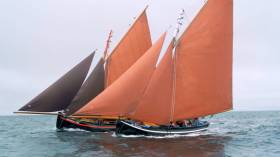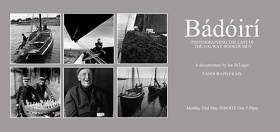Displaying items by tag: Bádóirí
On the western edge of Europe lies a unique culture that depended and fought with the Atlantic Ocean for thousands of years.
It is the native sailboat, the Galway Hooker, that sustained this poorest of communities, and the new generation of these same families of sailors still sail the coast of Connemara, now racing to be champions.
TG4’s documentary Bádóiri, now in its second series, follows the historic boats as they awaken from the long Connemara winter, only to find new contenders aboard for this season’s Galway Hooker Racing League regattas.
The preparations have started in earnest, and the show will keep up with the sailors as they race each other in the first of the summer’s races.
In series one we saw the family owned boats battle one another for the coveted prize of All-Ireland champions. In this new series, we introduce a new boat and a new family to the fleet.
Young and eager to impress, this new crew from The Truelight become a racing force to be reckoned as all the crews push themselves and their boats to their limit.
This second series also delves deeper into sailing families lives and histories.
An illness to one of the skippers bring the boatmen together where they share their personal stories as well as their hopes and fears from their sailing culture. Towards the end of the series, the racing and rivalry becomes more intense and the waters become treacherous.
Producer and director Donncha Mac Con Iomaire says: “There are few societies in the world where a 200-year-old boat is the epicentre of the same family for two centuries.
“The maritime community of Connemara never underestimates the Atlantic, and the unity of their families cannot afford to succumb to failure at sea. This ancient world that works hard and plays hard is what is still most genuine culture of Ireland.”
Bádóiri returns tonight, Thursday 5 March, at 8pm on TG4.
#OnTV - A new four-part documentary series on the people of Ireland’s west who keep the Galway Hooker sailing tradition alive behind tomorrow night (Thursday 10 January) at 8pm on TG4.
Bádóirí provides an insight into seven Connemara families, part of one of the few indigenous communities of sailors left in Europe, as they compete to be champions of the Galway Hooker Association Racing League.
The first of four episodes screens tomorrow at 8pm and will be available to stream for viewers in Ireland on the TG4 Player.
Bádóirí-Photographing the Last of the Galway Hooker Men – RTE One Documentary Airs This Month
'Bádóirí–photographing the last of the Galway Hooker Men’ a documentary by sailor and photographer Joe St. Leger will air on RTE One television on Monday 23rd May 2016 at 7.30pm.
The film relates the story of these unique Irish workboats and the men who sailed them using black and white photographs taken over 35 years ago when St. Leger was starting out as a photographer with the Irish Press in Dublin
Using still images and film footage taken over thirty years ago photographer St Leger tells the story of photographing the last of the hooker boatmen of Connemara.
For centuries Galway hookers sailed the waters of Galway Bay transporting people, goods and animals and connecting remote coastal communities with the Aran Islands, Galway city and market towns like Kinvara.
Transport and fishing once provided work for hundreds of these boats and their crews but by the 1960s their working days were coming to an end and many old boats were abandoned.
In the 1980’s attempts were made to revive interest in the craft starting with the annual Crinniú na mBád or Gathering of the Boats in Kinvara and to preserve for for future generations the skills needed to build and to sail them.
This film uses photographs taken during the revival to document what remained of the Galway hookers and of the people and places associated with them.
































































